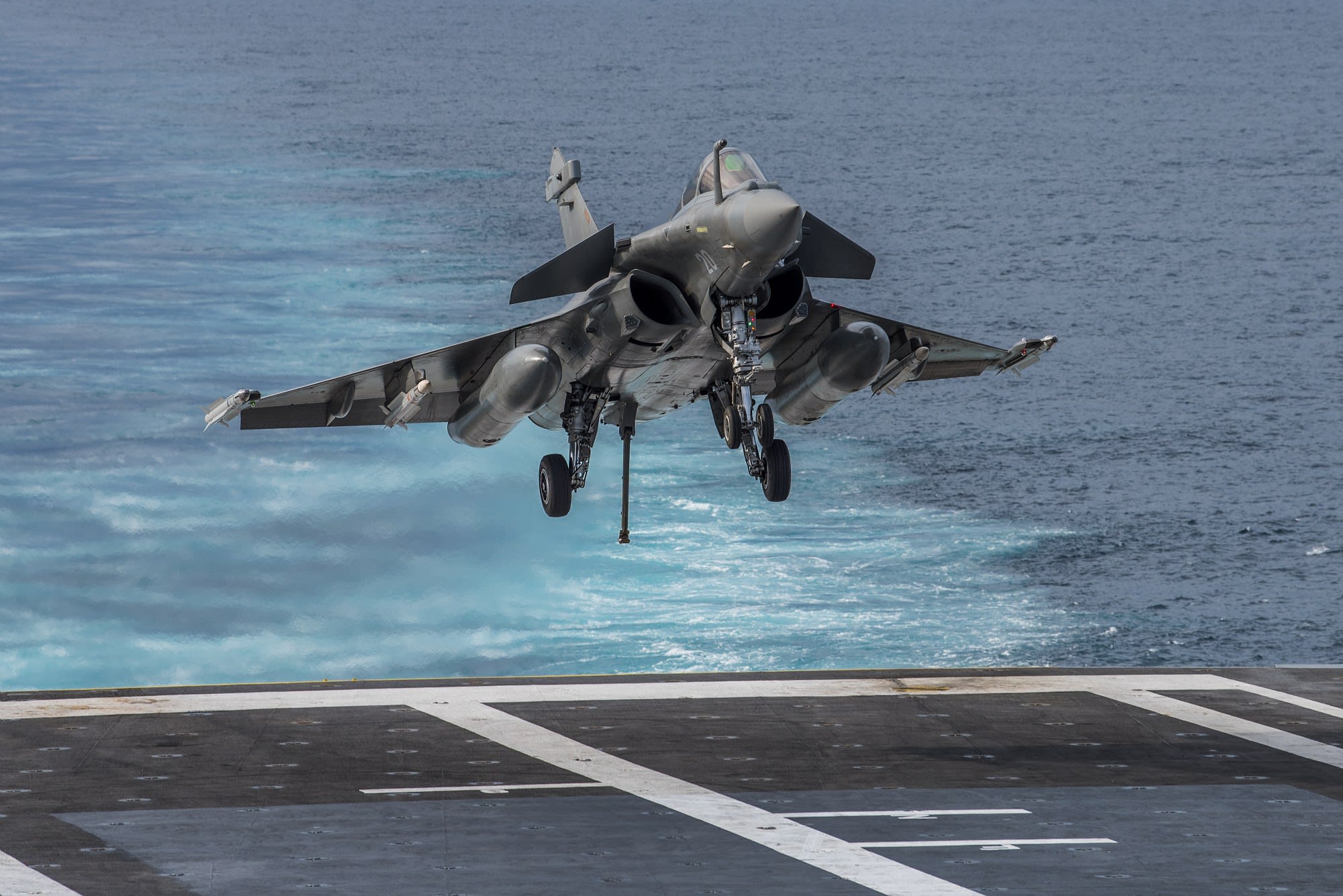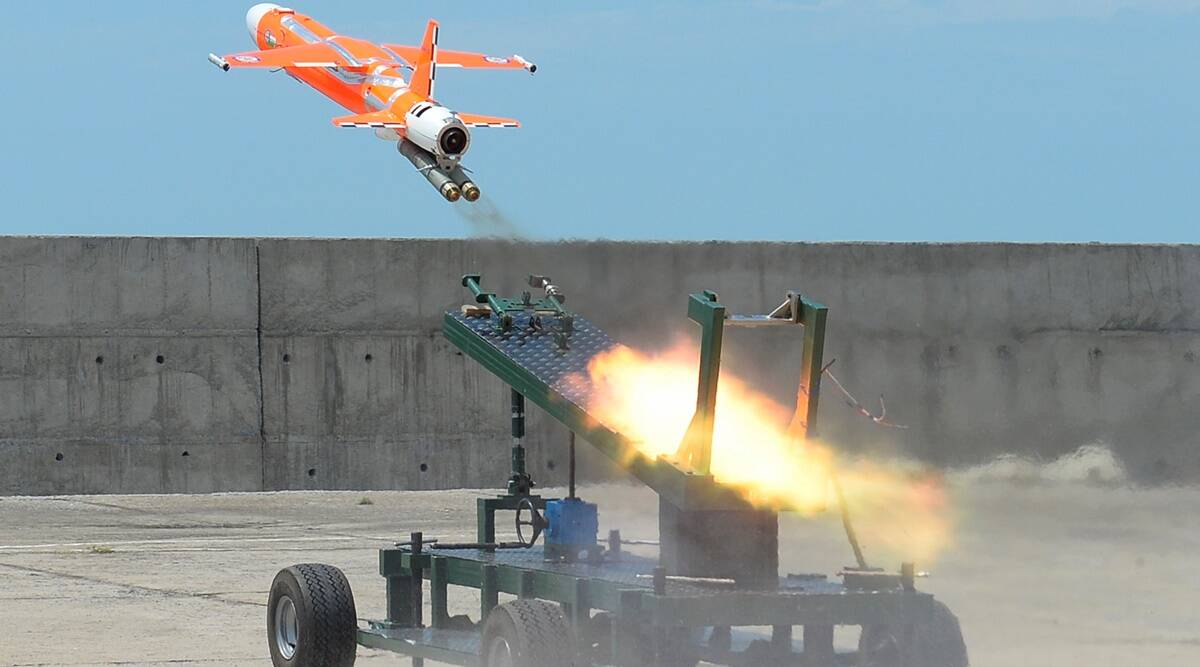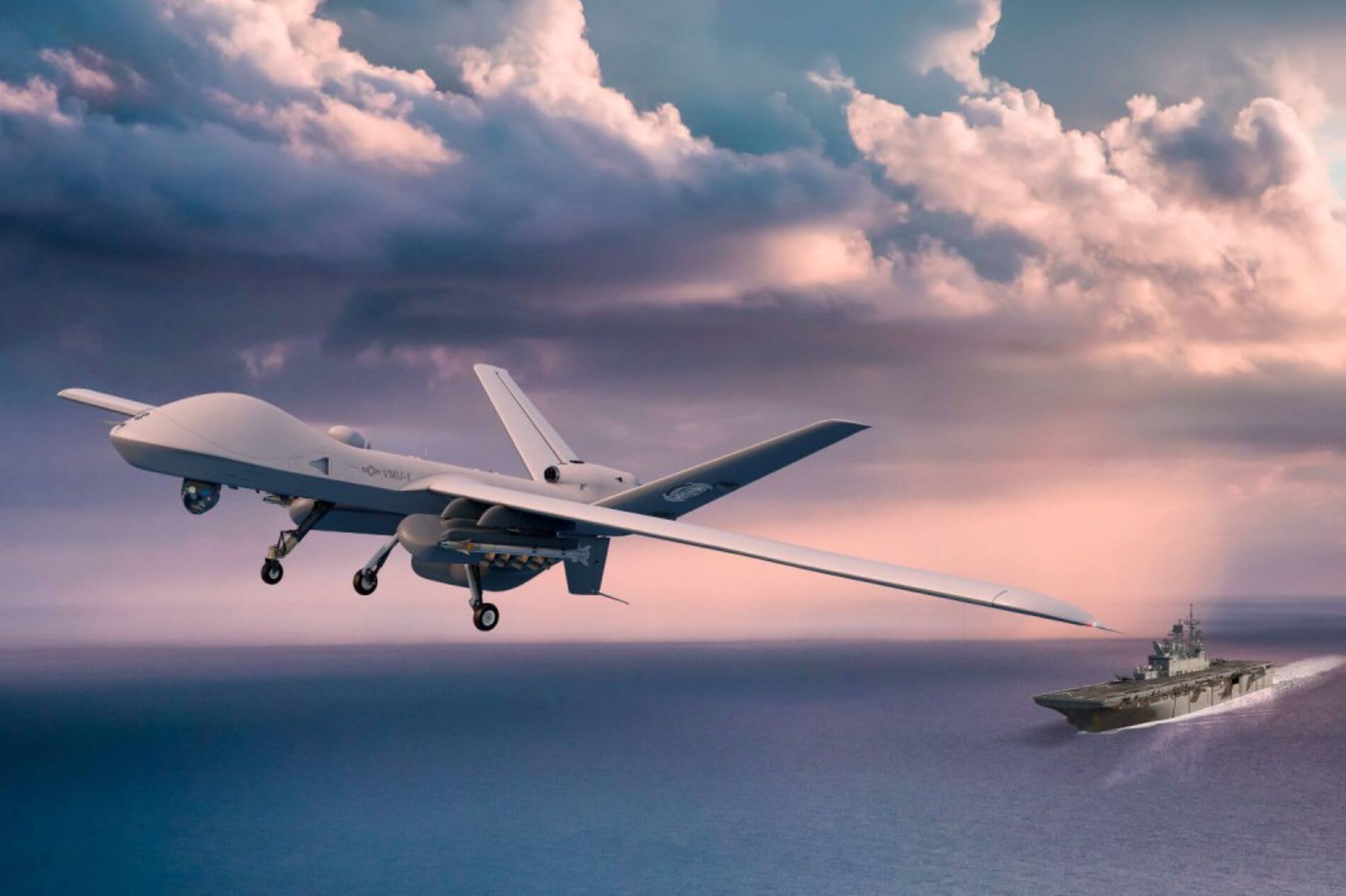SOURCE: IDRW.ORG TEAM

In a significant move aimed at fortifying its naval capabilities, India has embarked on a crucial deal worth a staggering 6 billion US dollars with France. This deal involves the acquisition of 26 cutting-edge Rafale Marine aircraft, designed to provide a substantial boost to the Indian Navy’s aircraft carrier fleet.
Government sources have confirmed that India recently submitted a formal Letter of Request to the French government, marking the initiation of negotiations for this high-stakes agreement. The acquisition includes 22 single-seated Rafale marine aircraft and four twin-seater trainer versions, all of which are destined to become an integral part of the Indian Navy’s defense operations on its aircraft carriers.
Continue readingSOURCE: RAUNAK KUNDE / NEWS BEAT / IDRW.ORG
The Aeronautical Development Establishment (ADE) is endeavouring to usher in the next generation of remotely piloted aircraft systems (RPAS) designed for intelligence, surveillance, and reconnaissance (ISR) operations. However, the proposed High-Altitude, Long-Endurance (HALE) RPAS has yet to gain significant traction within the Indian Army and Indian Air Force.
This hesitation can be attributed to concerns arising from the less-than-satisfactory performance of ADE’s earlier work on Medium-Altitude, Long-Endurance (MALE) UAV programs like Tapas. With both the Army and the Air Force poised to place orders for the MQ-9B SkyGuardian, they are urging ADE to utilize the SkyGuardian as a benchmark for developing the indigenous HALE UAV program.
Continue readingSOURCE: RAUNAK KUNDE / NEWS BEAT / IDRW.ORG
The Philippines Air Force (PAF) is embarking on a critical modernization program, with a total approved budget of 61.2 billion pesos (US$1.11 billion), to bolster its air defence capabilities. The primary focus of this endeavour is to procure 12 new combat aircraft under the Multi-Role Fighter (MRF) program. These fighters will play a pivotal role in safeguarding the country’s territorial integrity and interests in its exclusive economic zone (EEZ). A three-way race is currently underway, featuring Lockheed Martin’s F-16V, Saab’s Gripen C/D, and India’s HAL LCA-Tejas Mk1A.
One of the key requirements for the new fighter jets is their ability to carry an advanced anti-ship missile (AShM) that can be air-launched. This capability is essential for the Philippines to protect its maritime interests and enhance its deterrence capabilities in the region. The choice of AShM will significantly impact the effectiveness of the PAF’s fighter fleet.
Continue readingSOURCE: RAUNAK KUNDE / NEWS BEAT / IDRW.ORG

During the eighth Aerospace & Defence Manufacturing Show (ADMS) held on October 26 and 27, 2023, in Bangalore, India, the Aeronautical Development Establishment (ADE), an agency under the state-owned Defence Research and Development Organisation (DRDO), unveiled an updated configuration of the Abhyas High-speed Expendable Aerial Target (HEAT).
The original Abhyas configuration, launched in 2013, featured twin underslung boosters. However, the new configuration boasts a single underslung booster with an improved rocket motor, an extended length of 2.44 meters, and a new wingspan (specific dimensions were not disclosed).
Continue readingSOURCE: IDRW.ORG TEAM

In recent years, Russia has been facing challenges in its long-standing arms trade relationship with India. The economic sanctions imposed on Russia have hindered India’s ability to make payments for weapon imports, causing a significant reduction in the volume of arms purchases from its traditional partner. This shift in dynamics has prompted Russia to explore new avenues for cooperation, leading to a notable change in the format of their military-technical collaboration.
The 21st meeting of the India-Russia Working Group on Military-Technical Cooperation and Defence Industry, held in New Delhi on October 27, 2023, marked a significant milestone in this evolving partnership. During the meeting, Russia proposed a new working process to India, aiming to adapt to the changing circumstances in the global arms trade market. The core of this proposal involves a transition from supplying complete weapons systems to providing India with technology and systems, enabling the country to domestically manufacture its own weapons.
Continue readingSOURCE: IDRW.ORG TEAM

The Flying Instructors’ School (FIS) at Air Force Station Tambaram is all set to commemorate its remarkable 75-year journey with a grand celebration on November 3 and 4. The Chief of the Air Staff, Air Chief Marshal VR Chaudhari, will be in attendance at this special event, where many serving and retired alumni of the institution will join in the festivities.
In conjunction with this milestone, India’s renowned state-owned enterprise, Hindustan Aeronautics Limited (HAL), has put forth an ambitious proposal to develop the HLFT-42, a cutting-edge supersonic trainer aircraft weighing 16 tons. This initiative aims to establish a compelling case for incorporating the Light Combat Aircraft (LCA) Lead-In Fighter Trainer (LIFT) aircraft into the existing Pilot training curriculum.
Continue readingSOURCE: RAUNAK KUNDE / NEWS BEAT / IDRW.ORG

In a remarkable stride in India’s indigenous defence manufacturing, the Twin Engine Deck Based Fighter (TEDBF) project, designated for the Indian Navy and to be manufactured by Hindustan Aeronautics Limited (HAL), is set to receive a significant boost. The project is poised to incorporate the cutting-edge DRDO-Safran-developed 110kN engine, marking a critical milestone in India’s quest for self-reliance in defence production.
The collaborative effort between the Defense Research and Development Organization (DRDO) and Safran has reached an advanced stage, with discussions focused on establishing a comprehensive framework for the development of this state-of-the-art engine. The engine’s significance extends beyond TEDBF, as it is earmarked for deployment in the Advanced Medium Combat Aircraft Mk2 (AMCA) fighter jets, set to enter service from 2034-35 onwards. What makes this development even more noteworthy is that the engine is entirely manufactured within India, aligning with the country’s ‘Make in India’ initiative.
Continue readingSOURCE: RAUNAK KUNDE / NEWS BEAT / IDRW.ORG

The ongoing conflict in Ukraine has cast a shadow over the delivery of two Krivak-class stealth frigates, also known as Talwar-class, which were under construction for the Indian Navy in Russia. According to Alexey Rakhmanov, the Director-General of the United Shipbuilding Corporation of Russia, these frigates are now expected to be delivered by May and October 2024, respectively.
This delay is a further setback to the Indian Navy’s long-standing efforts to bolster its naval capabilities. The story of these frigates is entwined with geopolitical developments that have unfolded over the years.
The journey of these warships began when India sought to procure them after Ukraine refused to supply engines for the Russian Navy’s vessels following Russia’s annexation of Crimea in 2014.
SOURCE: RAUNAK KUNDE / NEWS BEAT / IDRW.ORG

India’s Air Force (IAF) operates a fleet of Advanced Light Helicopters (WSI) and Light Combat Helicopters (LCH), each playing a pivotal role in the nation’s air defence strategy. To equip these helicopters with the necessary air-to-air missile capabilities, the MISTRAL WVR Air-to-Air Missiles are a requirement. Embracing the principles of the Atmanirbhar Bharat (self-reliant India) initiative, there is a growing need to manufacture these advanced missiles within the country.
To achieve this goal, the proposal is to produce MISTRAL WVR Air-to-Air Missiles for ALH (WSI) and LCH helicopters, following the “Make III” procedure outlined in Chapter III of the Defense Acquisition Procedure 2020 (DAP 2020). The initial phase will encompass the production of ten missiles, with a projected quantity of approximately 100 units.
Continue readingSOURCE: IDRW.ORG TEAM
:quality(70)/cloudfront-us-east-1.images.arcpublishing.com/archetype/S6SVEVXUJVC3VN7CFAVPNHUDPI.jpg)
The recent AUKUS arrangement, a trilateral security partnership between Australia, the United States, and the United Kingdom, has generated significant attention for its primary focus on submarine technology development. However, for India, a country keen to bolster its naval capabilities, the doors to AUKUS do not seem to be opening as hoped. While AUKUS has firmly ruled out the possibility of India’s participation in submarine technology collaboration, diplomatic sources suggest there might still be room for broader technology cooperation under a different pillar of engagement.
India has been actively seeking access to the latest in nuclear submarine technology, primarily for its strategic interests in the Indo-Pacific region. While India had not planned an outright purchase of American nuclear attack submarines, it aimed to secure assistance from the United States in advancing its own indigenous nuclear-powered ballistic missile submarine (SSBN) program. The objective was to bridge the technology gap between India’s submarine capabilities and those of major players like the United States.
Continue readingSOURCE: IDRW.ORG TEAM

Dabolim, Goa, known for its pristine beaches and lush landscapes, is also home to a hidden gem that attracts history enthusiasts and aviation aficionados alike – the Naval Aviation Museum. Situated adjacent to the INS Hansa Naval base, this museum is set to become even more captivating as it prepares to welcome a new addition, the second vintage Ilyushin 38SD Sea Dragon.
This intriguing aircraft, recently retired from operational service, will soon find its place of honor among the exhibits at the Naval Aviation Museum in Dabolim. It’s a significant milestone for the museum, which had previously added a similar vintage aircraft to its collection in March 2020.
Continue readingSOURCE: RAUNAK KUNDE / NEWS BEAT / IDRW.ORG

In a significant development, Safran Aircraft Engines, a global leader in aero engine design, has partnered with the Defense Research and Development Organisation (DRDO) in India to jointly develop a powerful 110kN high-thrust engine for the upcoming Advanced Medium Combat Aircraft (AMCA) Mk2. This collaborative effort not only marks a major milestone in indigenous defence production but also paves the way for advanced capabilities in India’s fighter jet programs.
Under this groundbreaking partnership, Safran Aircraft Engines has committed to ensuring that all components of the new high-thrust engine will be locally manufactured in India. This commitment aligns with the “Make in India” initiative and showcases a strong dedication to fostering domestic production capabilities. Additionally, both countries will share joint intellectual property rights (IPR), emphasizing a mutually beneficial collaboration.
Continue readingSOURCE: RAUNAK KUNDE / NEWS BEAT / IDRW.ORG

In a noteworthy development, the Indian Navy has submitted a substantial proposal to the Ministry of Defence, urging approval for the production and procurement of a second indigenous aircraft carrier. The Navy intends to recommend the project to Cochin Shipyard Limited, a move that signifies the nation’s commitment to strengthening its maritime capabilities. The Ministry of Defence is set to convene soon to evaluate and sanction the Navy’s proposal.
The second indigenous aircraft carrier, known as IAC-II, will undergo modifications to facilitate the deployment of Unmanned Combat Aerial Vehicles (UCAVs) and High-Altitude Long Endurance (HALE) Unmanned Aerial Vehicles (UAVs). These advanced aircraft are currently under development in collaboration with the Defence Research and Development Organization (DRDO) and will possess Short-Takeoff and Landing (STOL) capabilities. These unique aircraft can take off in as little as 586 feet and execute short landings within just 335 feet.
Continue readingSOURCE: RAUNAK KUNDE / NEWS BEAT / IDRW.ORG

India’s esteemed state-owned aerospace and defence company, Hindustan Aeronautics Limited (HAL), is embarking on a significant endeavour that promises to reshape the country’s military aviation capabilities. HAL is currently at the forefront of two groundbreaking helicopter programs: the Indian Multi-Role Helicopter (IMRH) designed for the Indian Air Force and Indian Army, and the Deck-based Multi-Role Helicopter (DBMRH) tailored for the Indian Navy. These ventures are expected to secure approximately 400 orders, ensuring the sustained operation of production lines well into 2045.
The IMRH program is poised to adopt an innovative approach by implementing the Special Purpose Vehicle (SPV) model, where private sector companies will hold a substantial stake in the newly formed entity. Production of the IMRH is scheduled to commence in 2031, initially producing six units annually. This rate will progressively increase to 12, 24, and eventually 30 units per year from 2035 onwards, with this pace maintained until 2044.
Continue readingSOURCE: IDRW.ORG TEAM

The Indian Navy, Twin-Engine Deck-Based Fighter (TEDBF) program is currently undergoing significant design modifications, primarily aimed at aligning it with the Indian Navy’s requirements for a fifth generation “minus,” that is just shy of being classified as 5th gen. While these developments are well underway, it has reignited a pertinent debate within the defense circles of why the Indian Air Force (IAF) is not considering procuring an Air Force variant of the TEDBF. This debate has raised questions about potentially saving time and cost for the nation, sparing the Exchequer from the considerable financial strain required to fund foreign exchange reserves worth nearly $20 billion.
The TEDBF program, led by the Aeronautical Development Agency (ADA), was initially intended to cater to the Navy’s need for a 26-ton Medium class deck-based fighter jet. ADA went a step further by offering to develop an Air Force variant, sans naval landing gears and featuring a hardened rear fuselage, aptly named ORCA. The proposed ORCA variant, boasting a maximum takeoff weight of approximately 23.5 tons, could have placed it in the same league as the formidable Rafale fighter jet. This proposed design, which featured more potent engines and a near-stealth configuration, had the potential to be a game-changer.
Continue reading